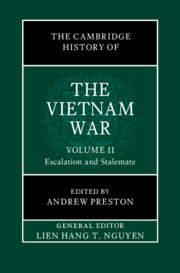Book contents
- The Cambridge History of the Vietnam War
- The Cambridge History of the Vietnam War
- The Cambridge History of the Vietnam War
- Copyright page
- Contents
- Figures
- Maps
- Tables
- Contributors to Volume II
- General Introduction
- Introduction
- Part I Battlefields
- Part II Homefronts
- Part III Global Vietnam
- 24 International Radicalism and Antiwar Protest
- 25 The Vietnam War and the Sino-Soviet Split
- 26 Western Europe and the Vietnam War
- 27 International Peace Initiatives
- 28 Japan and the Vietnam War
- 29 The Economics of the Vietnam War
- 30 Vietnam and the Global 1968
- Index
28 - Japan and the Vietnam War
from Part III - Global Vietnam
Published online by Cambridge University Press: 02 January 2025
- The Cambridge History of the Vietnam War
- The Cambridge History of the Vietnam War
- The Cambridge History of the Vietnam War
- Copyright page
- Contents
- Figures
- Maps
- Tables
- Contributors to Volume II
- General Introduction
- Introduction
- Part I Battlefields
- Part II Homefronts
- Part III Global Vietnam
- 24 International Radicalism and Antiwar Protest
- 25 The Vietnam War and the Sino-Soviet Split
- 26 Western Europe and the Vietnam War
- 27 International Peace Initiatives
- 28 Japan and the Vietnam War
- 29 The Economics of the Vietnam War
- 30 Vietnam and the Global 1968
- Index
Summary
The Vietnam War was a significant turning point in modern Japanese history and the US–Japanese alliance. Though constitutional restrictions prevented Japan from sending troops, its government actively supported the US war effort politically, financially, and logistically, and US military bases in Japan were crucial to the US war effort. Japanese prime minister Satō Eisaku leveraged this support into a significant geopolitical goal: the return of the Ryukyu Islands, including Okinawa, which had been under US occupation since 1945. Wartime procurement demands for Japanese products and war materiel also allowed Japan to expand its economic ties with the United States, Vietnam, and other Asian countries, furthering the economic takeoff that had begun in the late 1950s. This sustained economic growth had contradictory and ironic consequences. On the one hand, it fostered intense tensions with the United States, which helped fuel far-reaching shifts to American economic policy (the so-called Nixon Shocks). On the other hand, it helped the Japanese government weather intense criticism from a large-scale antiwar movement, which emphasized grassroots citizen activism and sought to end Japan’s complicity in the war. The Vietnam War therefore initiated economic, diplomatic, and political shifts that would continue to shape Japan for decades.
Keywords
- Type
- Chapter
- Information
- The Cambridge History of the Vietnam War , pp. 604 - 624Publisher: Cambridge University PressPrint publication year: 2024

